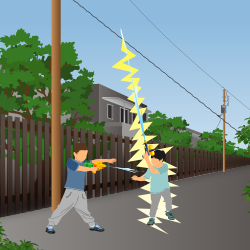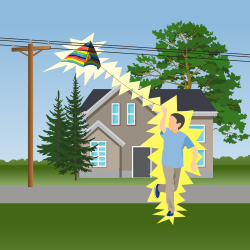What you should always do BEFORE climbing a ladder or using other long or tall equipment (poles, etc.)
- 1Look for power lines nearby.
- 2Keep everyone and everything at least 3 m away from a medium-voltage line.
- 3Also be sure that nothing touches the low-voltage lines (including the lines connected to the service entrance of your home). Even though they’re insulated, the sheathing may be cracked and therefore inadequate.
Vidéo : Before starting any outdoor workr
Learn about safety habits to adopt when working around the house and the importance of keeping your distance from power lines.
Vidéo : Kids at play and power lines
Learn safety tips for kids playing outdoors this summer and the importance of always staying away from power lines.
Activities during which you need to be especially careful
- Pruning or cutting down a tree
- Trimming a hedge
- Building a treehouse
- Using a ladder
- Delivering materials with a crane or cherry-picker
- Working on scaffolding or a cherry-picker
- Working on a roof
- Cleaning out eavestroughs
- Skimming a pool
- Putting up holiday decorations or a Christmas tree
- Piling up snow and playing on a big pile of snow
- Playing with a water blaster
- Flying a kite or drone
- Approaching a downed power line
- What to do if a car hits a utility pole and damages it
- Kitesurfing
Pruning or cutting down a tree
Pruning or cutting down a tree is more dangerous than you think. Before you climb a ladder into a tree, always take a careful look around for nearby power lines. The safe distance for your work depends on the type of pruning or size of the tree to cut down. If the danger of falling branches is not properly assessed, there is a serious risk of injury or shock if a branch comes in contact with a line. When pruning or cutting down a tree, hiring a professional arborist is the best—and safest—option!


Trimming a hedge
Trimming a hedge can pose a risk if there are power lines overhead. Before you climb a ladder into a hedge or use a long-reach hedge trimmer, always take a careful look around for nearby power lines. It is also important to consider the height of the hedge. Keep yourself and your tools and instruments at least three metres from power lines. If you or your tools or instruments get too close, there is a serious risk of injury or shock. When trimming a hedge, hiring a professional arborist is the best—and safest—option!
Building a treehouse
So many children dream of a treehouse! But before you build one, always take a careful look around for nearby power lines. It is also important to make sure there are no lines running through the tree. Remember that branches will grow over time and must never come in contact with power lines. Make sure the children can safely climb the tree and play in their treehouse without running the risk of electric shock.


Using a ladder
Before using a ladder, take a quick look around the area where you intend to work to locate Hydro‑Québec power lines, which may be hidden in a tree’s highest branches. When you are ready to set up the ladder, remain careful at all times. You don’t want uneven ground, a gust of wind or a simple distraction to cause you to lose your balance, since the top of the ladder could then come in contact with a power line. To eliminate the risk, always place your ladder at least three metres from a power line. Ideally, choose a ladder made of fiberglass or another nonconductive material. Don’t run the risk of a potentially lethal electric shock.
Delivering materials with a crane or cherry-picker
Whether you are a professional or just helping a friend, you put your life at risk when you use a crane or cherry-picker near Hydro‑Québec power lines. When you arrive, take a quick look around the area where you intend to work to locate them. Make sure the crane or cherry-picker is within a safe distance—three metres away—at all times. Don’t run the risk of a potentially lethal electric shock.


Working on scaffolding or a cherry-picker
Work near Hydro‑Québec power lines requires considerable caution. A minimum distance of three metres must be kept at all times when handling the materials and tools required to carry out the work. When you work on scaffolding or a cherry-picker, you are closer to the power lines. Still, you must keep a safe distance of at least three metres at all times. For example, a window or an eavestrough can get too close to the lines during installation. A gust of wind or wrong move can quickly cause a potentially fatal electric arc, so keep a safe distance! Make sure you and your tools and instruments are at least three metres from power lines. If that is not possible at all times, you must ask for safety measures to be implemented. Read the General Information Sheet – Work Near Power Lines [PDF 248.9 kB] to learn more.
Working on a roof
Working on a roof means working at height! And that often means working near power lines. Clearing snow, installing or cleaning eavestroughs and replacing roof coverings is high-risk work. Consider hiring a professional or, if you do the work yourself, read the General Information Sheet – Work Near Power Lines [PDF 248.9 kB] to stay safe.
No matter what the situation, never minimize the risk of electric shock and always keep a safe distance of three metres from power lines.


Cleaning out eavestroughs
To clean out eavestroughs, you need to use a long pole or climb a ladder. For your own safety, choose a pole or ladder made of nonconductive materials (fiberglass is ideal, wood is also acceptable). When cleaning out eavestroughs, take a look around the area where you intend to work and locate the power lines. Most importantly, keep an eye on the tops of the pole or ladder and any tools so they don’t touch the lines. Use nonconductive tools and always keep a safe distance of three metres from Hydro‑Québec power lines.
Skimming a pool
Even though the lines that connect a home to the power system are covered with an insulating sheath, it could be damaged. There is always a risk of serious electric shock. Before using a skimmer, look around the pool to stay safe.
Opt for a fiberglass long-handled skimmer rather than an aluminum one. Fiberglass provides better insulation than aluminum, which is a good conductor of electricity.


Putting up holiday decorations or a Christmas tree
A Christmas tree outside a house always looks beautiful. But remember that the taller it is, the greater the risk of touching a power line. Before you choose your tree, take a careful look around to make sure there are no power lines nearby. Don’t climb a ladder to hang the decorations on a windy day. Choose a ladder or pole made of nonconductive materials, like fiberglass or wood, and be careful when installing the lights and ornaments. Always keep a safe distance of three metres from Hydro‑Québec power lines.
When hanging outdoor holiday lights, be sure to use extension cords that are in good condition and designed for outdoor use. Don’t overload the sockets with too many extension cords.
Piling up snow and playing on a big pile of snow
Whether it’s in a parking lot or schoolyard or during snow removal operations, it’s important to pile snow in the right spot, far from power lines. Large snowbanks quickly become fun playgrounds to climb and slide down, but kids can get too close to power lines and risk severe shock or even death by coming in direct or indirect contact with them.
If you see a pile of snow that seems dangerous, alert authorities by calling 911. Emergency services will take the necessary steps to ensure people are safe.


Playing with a water blaster
Water blasters have huge tanks so they can shoot a continuous stream over a distance of several metres. When the spray hits a line, it’s just as if the hands holding the water blaster were touching it directly. It is extremely dangerous, so always spray safely!
Flying a kite or drone
Flying a kite is so much fun that it’s easy to forget about overhead power lines. Remind children to always look out for power lines and keep a safe distance. A kite that gets tangled in power lines can conduct electricity. If the ground is wet, the risk of serious shock is even higher. It is always safer to fly a kite in an area where there are no power lines nearby.
Never steer a drone near Hydro‑Québec power lines or a transformer substation. If your drone happens to land behind the fence of a Hydro‑Québec substation, don’t try to get it yourself. You’d be risking your life. The area is fenced off because it is very dangerous to access. To get your drone back, contact Hydro‑Québec customer services and explain the situation. A specialist will retrieve it for you on their next planned visit to the substation.


Approaching a downed power line
When a power line is in contact with the ground or your vehicle, it is likely still live, even if it seems to be cut or damaged. The ground around it can also conduct electricity and cause shock. Always keep a safe distance and never use anything to try to move a line. Even a tree branch can conduct electrical current.
To report a downed line, call 911.
Collision with a utility pole
When a vehicle hits a utility pole, a line may be damaged or cut and fall to the ground. You may not even see the line, which could still be live. There is a significant risk of severe shock if you happen to touch it. The ground around it can also conduct electricity and cause shock. The best thing to do is to remain in the vehicle and not touch any metal parts inside it. Stay calm and immediately call 911. Do not exit the vehicle. If bystanders try to help you, tell them not to approach the vehicle and, above all, not to touch it.


Kitesurfing
A kite board isn’t always easy to maneuver. If you lose control of the kite, you could quickly come too close to power lines before you regain control. There is a risk of severe electric shock or even death. Enjoy the wind and have fun, but always stay at least 75 m (245 ft.) from power lines. Don’t put your life at risk!